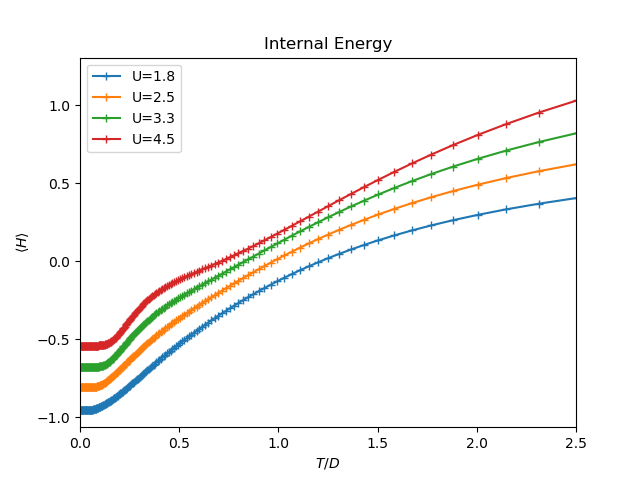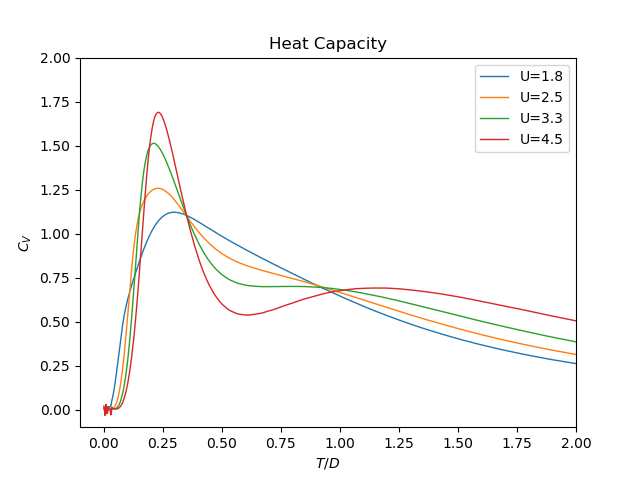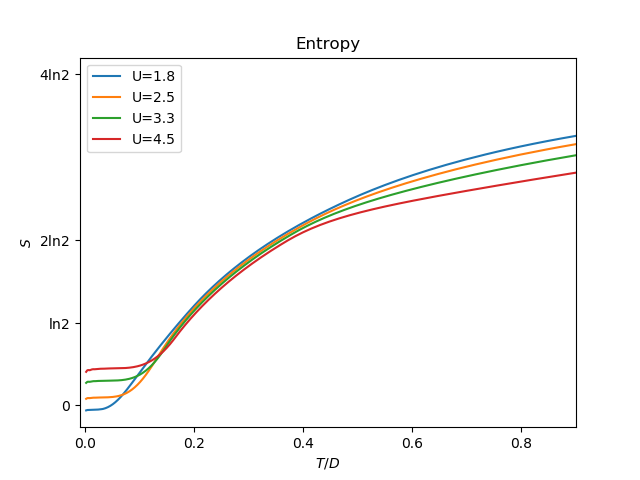Thermodynamics of the Band insulator in the Dimer lattice¶
In the weakly correlated region at $t_perp=0.8$ the Thermodynamics of the system is calculated.
from math import log, ceil
import numpy as np
from scipy.integrate import simps
import matplotlib.pyplot as plt
import dmft.dimer as dimer
import dmft.common as gf
from dmft.utils import differential_weight
def loop_beta(u_int, tp, betarange, seed):
avgH = []
for beta in betarange:
tau, w_n = gf.tau_wn_setup(
dict(BETA=beta, N_MATSUBARA=max(2**ceil(log(8 * beta) / log(2)), 256)))
giw_d, giw_o = dimer.gf_met(w_n, 0., 0., 0.5, 0.)
if seed == 'I':
giw_d, giw_o = 1 / (1j * w_n - 4j / w_n), np.zeros_like(w_n) + 0j
giw_d, giw_o, _ = dimer.ipt_dmft_loop(
beta, u_int, tp, giw_d, giw_o, tau, w_n, 1e-6)
ekin = dimer.ekin(giw_d[:int(8 * beta)], giw_o[:int(8 * beta)],
w_n[:int(8 * beta)], tp, beta)
epot = dimer.epot(giw_d[:int(8 * beta)], w_n[:int(8 * beta)],
beta, u_int ** 2 / 4 + tp**2 + 0.25, ekin, u_int)
avgH.append(ekin + epot)
return np.array(avgH)
fac = np.arctan(25 * np.sqrt(3) / 0.45)
temp = np.tan(np.linspace(5e-3, fac, 185)) * 0.45 / np.sqrt(3)
BETARANGE = 1 / temp
U_int = [1.8, 2.5, 3.3, 4.5]
TP = 0.8
avgH = [loop_beta(u_int, TP, BETARANGE, 'I') for u_int in U_int]
Internal Energy¶
The internal energy decreases and upon cooling but in the insulator it finds two energy plateaus
plt.figure()
temp_cut = sum(temp < 3)
for u, sol in zip(U_int, avgH):
plt.plot(temp[:temp_cut], sol[:temp_cut], '+-', label='U={}'.format(u))
plt.xlim(0, 2.5)
plt.title('Internal Energy')
plt.xlabel('$T/D$')
plt.ylabel(r'$\langle H \rangle$')
plt.legend(loc=0)

Specific Heat¶
In the heat capacity it is very noticeable how close one is to the
Quantum Critical Point as the Heat capacity is almost diverging for the
smallest  insulator
insulator
plt.figure()
temp_cut = sum(temp < 3)
CV = [differential_weight(H) / differential_weight(temp) for H in avgH]
for u, cv, h in zip(U_int, CV, avgH):
plt.plot(temp[: temp_cut], cv[: temp_cut], lw=1, label='U={}'.format(u))
plt.xlim(-0.1, 2.)
plt.ylim(-0.1, 2)
plt.title('Internal Energy')
plt.title('Heat Capacity')
plt.xlabel('$T/D$')
plt.ylabel(r'$C_V$')
plt.legend(loc=0)

Entropy¶
Entropy again find two plateaus as first evidenced by the internal
energy, it is also noteworthy that entropy seems to remain finite for
this insulator and would seem that is the same value for all cases being
numerical uncertainties to blame for the curves not matching at zero
temperature. It still remains unknown what the finite entropy value
corresponds to. In this particula case is 
ENDS = []
for cv in CV:
cv_temp = np.clip(cv, 0, 1) / temp
s_t = np.array([simps(cv_temp[i:], temp[i:], even='last')
for i in range(len(temp))])
ENDS.append(log(16.) - s_t)
plt.figure()
temp_cut = -1
for u, s in zip(U_int, ENDS):
plt.plot(temp[: temp_cut], s[: temp_cut], label='U={}'.format(u))
plt.title('Entropy')
plt.xlabel('$T/D$')
plt.ylabel(r'$S$')
plt.legend(loc=0)
plt.xlim(-0.01, 0.9)
plt.yticks([0, log(2), log(2) * 2, log(2) * 4],
[0, r'$\ln 2$', r'$2\ln 2$', r'$4\ln 2$'])
plt.show()

Total running time of the script: ( 0 minutes 9.401 seconds)